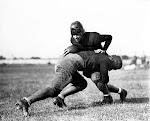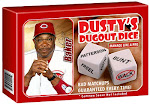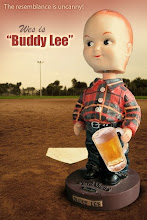 Michael MacCambridge's 2004 America's Game: The Epic Story of How Pro Football Captured a Nation:
Michael MacCambridge's 2004 America's Game: The Epic Story of How Pro Football Captured a Nation:
On the field, there was less room for segregation than ever before. During his first training camp with the Packers in 1959, Lombardi confronted his team about racism. "If I ever hear nigger or dago or kike or anything like that around here, regardless of who you are, you're through with me," he said. "You can't play for me if you have any kind of prejudice." Packers defensive back Willie Wood would call Lombardi "perhaps the fairest person I ever met." And his simultaneous commitment to and bullying of the players later prompted the lineman Henry Jordan's famous line, "He treats every man the same -- he treats us all like dogs."
Of all the instances of racism, the most embarrassing one was in the nation's capital. By the beginning of the 1961 season, there were eighty-three blacks on the NFL's fourteen clubs -- or, to be more precise, eighty-three on thirteen clubs, since the Washington Redskins, the self-professed Team of the South, which still played "Dixie" before all its home games, had abided by owner George Preston Marshall's edict not to use black players.
Even among Marshall's defenders, the best that could be said about him was that he was an opportunist rather than a racist, and that he kept his club segregated to avoid alienating the wide network of fans in the Deep South, where the Redskins barnstormed during the exhibition season, and broadcast their games during the regular season. The all-white Redskins were obviously at a competitive disadvantage due to the policy (the team suffered through a 1-12-1 record in 1961), but Marshall's vow -- "We'll start signing Negroes when the Harlem Globetrotters starting signing whites" -- seemed steadfast in the face of public opinion.
Few were more vigilant or persistent in their critique of the blustery Marshall than the Washington Post's sports columnist Shirley Povich, who brought that criticism to a kind of apex in his account of a Redskins-Browns game in 1960:For 18 minutes the Redskins were enjoying equal rights with the Cleveland Browns yesterday, in the sense that there was no score in the contest. Then it suddenly became unequal in favor of the Browns, who brough along Jim Brown, their rugged colored fullback from Syracuse. From 25 yards out, Brown was served the ball by Milt Plum on a pitch-out and he integrated the Redskins' goal line with more than deliberate speed, perhaps exceeding the famous Supreme Court decree. Brown fled the 25 yards like a man in an uncommon hurry and the Redskins' goal line, at least, became interracial.
By that fall, Marshall's stubborness had become a public embarrassment. The means for intervention first occurred to Kennedy's new secretary of the interior, Stewart Udall. The city's new D.C. stadium, where the Redskins would begin play in 1961, was built on federal land, as part of the National Capital Parks System, which as with all government buildings had clear rules forbidding discrimination in hiring. After checking first with Robert Kennedy to receive clearance from the administration to press the issue ("Go get him!" RFK told Udall. "Make him do it!"), Udall called a press conference in the spring, announcing that he had sent a warning letter to Marshall, advising the owner that the government was aware of the Redskins' reputation for practicing discrimination and to be aware of "the implications of this new regulation -- and our view of its import." After a couple of months of bluster from Marshall, during which Rozelle visited Washington for some private prodding, the owner finally capitulated, negotiating a compromise in late August that would allow the Redskins to play in D.C. Stadium in 1961, with the agreement that the team would be integrated by the beginning of the 1962 season.
It was a significant victory for the league, an important symbolic one for the administration, and another example in the growing tendency for the public to view the world of sports as a microcosm of the society at large.
Tags: Michael MacCambridge, America's Game Read more!




























.jpg)





